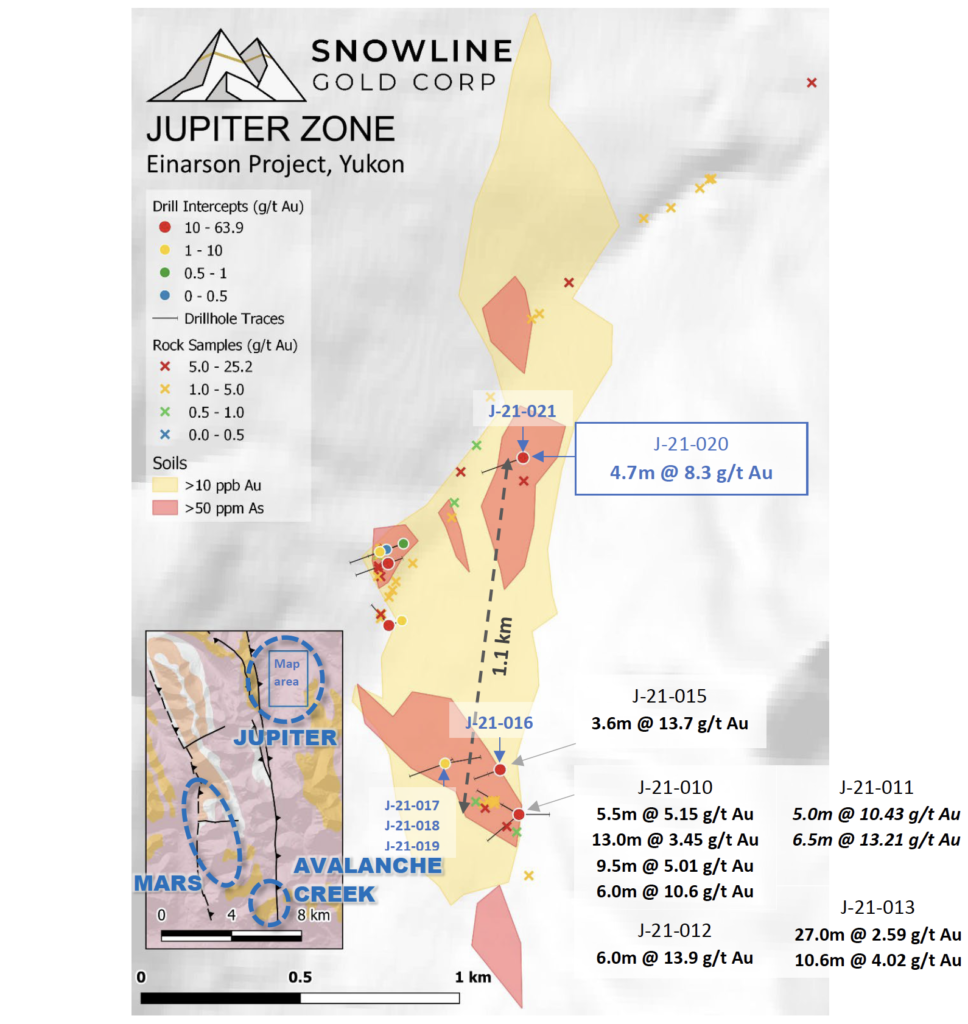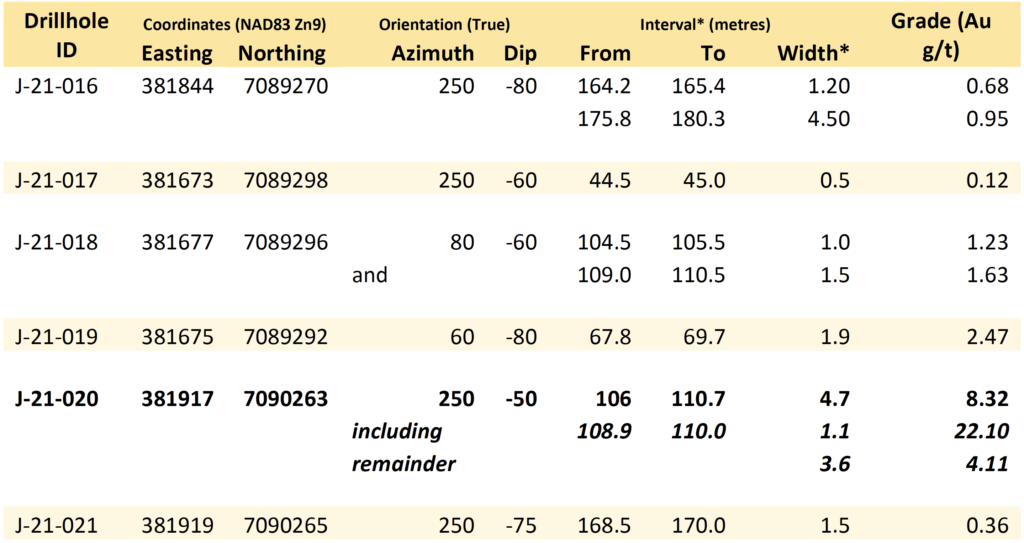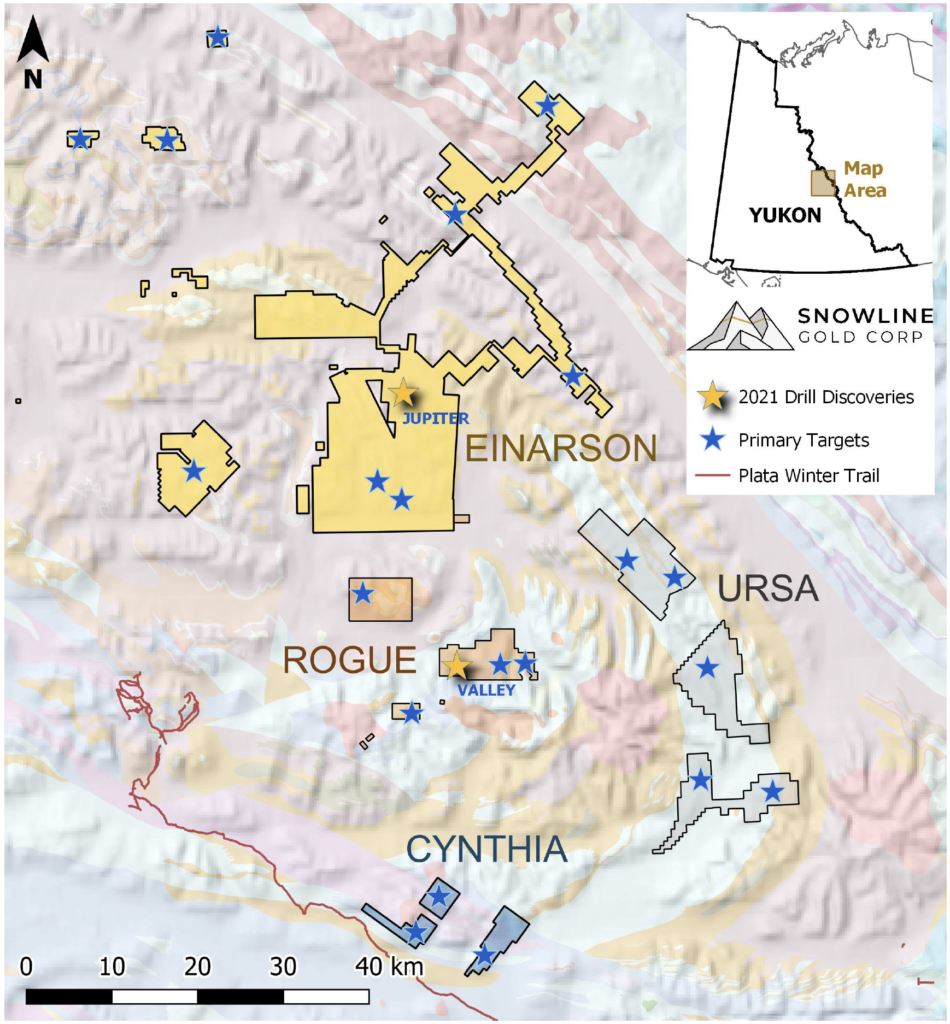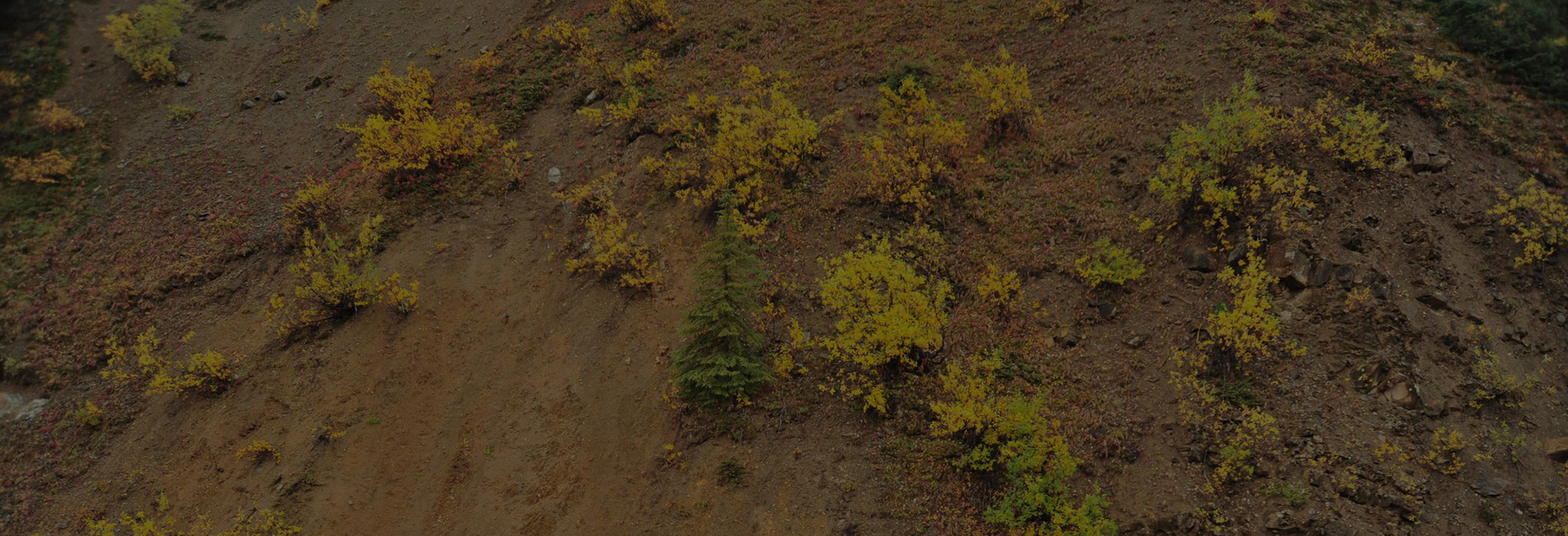•Diamond drill hole J-21-020 returned 8.3 g/t Au over 4.7 m in the first drill test of a new, covered target area at Jupiter
• Quartz breccia hosts fine-grained visible gold assayed 22.1 g/t Au over 1.1 m within above 4.7 m interval
• Hole J-21-020 was collared 1.1 km north of high-grade (>20 g/t Au) hits in holes J-21-010, 011, 012 & 013, demonstrating scale of mineralizing system
• Assays still pending for all 4 holes at Snowline’s Valley zone bulk-tonnage target 32 km south of Jupiter, each of which intersected visible gold and extensive zones of sheeted veins
Vancouver, B.C., January 12, 2022: SNOWLINE GOLD CORP. (CSE: SGD) (US OTC: SNWGF) (the “Company” or “Snowline”) is pleased to announce receipt of remaining assay results from Phase I drilling at the Jupiter zone on its district-scale Einarson gold project in the Yukon Territory, Canada. Among these results, hole J-21-020 returned 8.3 g/t Au over 4.7 meters, including 22.1 g/t Au over 1.1 meters in a quartz-carbonate vein breccia carrying visible gold. True widths for this intersection are not known but are estimated at approximately 90% of the reported interval.

Figure 1 – J-21-020, from 106.0 m to 111.4 m downhole, as previously shown in a September 3, 2021 Company release. The wide, stylolitic, acicular arsenopyrite-bearing quartz carbonate vein breccia from 108.9 m to 110.0 m downhole returned 22.1 g/t Au over 1.1 m. Instances of fine-grained visible gold were observed at 109.6 m and 109.8 m downhole. This sits within a broader zone of mineralized quartz carbonate veins and pyrite- and arsenopyrite-bearing siltstones from 106.0 m to 110.7 m downhole which averaged 8.3 g/t Au (including the above interval). Intersections are perpendicular to the core axis and thus suggest a close approximation of true widths, although the geometry of the mineralization is not yet known
“We are pleased to see high grades associated with the visible gold discovered in this new part of the Jupiter zone,” said Scott Berdahl, CEO and Director of Snowline Gold Corp. “While the area lacks mineralized outcrops to guide our decision-making at Jupiter, this target was particularly blind but it does have a broad geochemical anomaly. As a random shot through this target, today’s results are particularly encouraging—they give us a foot in the door in locating and delineating this new mineralization center. With results from widely space drilling over 1.1 km we are just scratching the surface. We look forward to expanding on this discovery and others as we further test the 3-km-long geochemical anomaly at Jupiter in the upcoming 2022 field season.”

The bottom of hole J-21-016 returned 0.95 g/t Au over 4.5 m from 175.8 m downhole. Holes 17 through 19 were drilled to test a possible parallel trend to the discoveries in holes 10-13 and 15, and they intersected grades of up to 3.2 g/t Au. Hole J-21-021, which was drilled at a steeper angle from the same pad as Hole 20, intersected a large pyritic zone with quartz carbonate material but generally subdued gold values (Table 1).

The style of mineralization in Hole J-21-020 is consistent with that observed on surface in quartz-carbonate float boulders and in drill discoveries made by Snowline earlier in the season on Jupiter, suggesting the presence of a large mineralized system. It is also consistent with occurrences of near-source float mineralization observed at the Avalanche Creek target, some 12 kilometers to the south of Jupiter.
This Phase I drill program represents the first ever drilling at Jupiter and marks the discovery of a new style of mineralization for this region of the Yukon. Jupiter is thought to represent an epizonal orogenic gold system, with similarities to systems like New Found Gold Corp.’s Queensway discoveries in Newfoundland and Agnico Eagle Mines Ltd.’s Fosterville mine in the Bendigo district of Australia.
Jupiter is one of nine target zones prospective for orogenic and/or Carlin-style gold mineralization currently recognized on Snowline Gold’s 70%-owned, district-scale Einarson project. Adjacent projects Rogue and Ursa are prospective for intrusion-related gold and sediment-hosted gold and base metal deposits. No resources nor reserves have been calculated on any of these targets, and while current results are encouraging, they do not guarantee that economically viable ore bodies will be encountered at Jupiter or elsewhere.

FORTHCOMING RESULTS
The Company awaits assay information for its four drill holes from the Valley zone on the nearby Rogue project, some 32 kilometers to the south of Jupiter. All four holes at Valley intersected trace amounts of visible gold in drill core. Valley is a reduced intrusion-related gold target that presents a bulk-tonnage gold exploration model where gold is hosted in widespread arrays of centimetre-scale sheeted quartz veins within and around a felsic intrusion.
In hole V-21-001, sheeted quartz veins were observed across its entire 161 m length. Thirty-one of the many veins observed in this hole contained trace amounts of visible gold, with up to five gold grains observed in a given vein. Visible-gold bearing veins were distributed roughly evenly across the length of the hole.
QA/QC AND QUALIFIED PERSON
On receipt from the drill site, drill core was systematically logged for geological attributes, photographed and sampled. Smaller sample lengths were used to isolate zones of interest, otherwise a default 1.5 m downhole sample length was used. Core was cut in half lengthwise, with one half collected for analysis and one half stored as a record. Standard reference materials, blanks and duplicate samples were inserted by Snowline personnel at regular intervals into the sample stream. Bagged samples were sealed with security tags to ensure integrity during transport. They were delivered by expeditor and by Snowline personnel to ALS Laboratories’ preparatory facility in Whitehorse, Yukon, with analysis completed in Vancouver.
ALS is accredited to ISO 17025:2005 UKAS ref 4028 for its laboratory analysis. Samples were crushed by ALS to >70% passing below 2 mm and split using a riffle splitter. 250 g splits were pulverized to >85% passing below 75 microns. An aqua regia digest with an inductively coupled plasma mass spectroscopy (ICP-MS) finish was used for 51-element analysis on 50 g samples (ALS code: Au-ME-TL44). Any sample returning >50 ppb Au was re-analysed for gold content by fire assay with an inductively coupled plasma atomic emission spectroscopy (ICP-AES) finish on 30 g samples (ALS code: Au-ICP21). Over-limit samples of >10 g/t Au were analyzed by fire assay with a gravimetric finish again on a 50 g sample (ALS code: Au-GRA22). Where more than one gold assay exists for a sample, assays reported herein prioritize these methods in reverse order.
Information in this release has been prepared and approved by Scott Berdahl, P. Geo., Chief Executive Officer of Snowline and a Qualified Person for the purposes of National Instrument 43-101.
ABOUT SNOWLINE GOLD CORP.
Snowline Gold Corp. is a Yukon Territory focused gold exploration company with a seven-project portfolio covering >100,000 ha. The Company is exploring its flagship 72,000 ha Einarson and Rogue gold projects in the highly prospective yet underexplored Selwyn Basin. Snowline’s project portfolio sits within the prolific Tintina Gold Province, host to multiple million-ounce-plus gold mines and deposits including Kinross’ Fort Knox mine, Newmont’s Coffee deposit, and Victoria Gold’s Eagle Mine. Snowline’s first-mover land position provides a unique opportunity for investors to be part of multiple discoveries and the creation of a new gold district.
ON BEHALF OF THE BOARD
Scott Berdahl, MSc, MBA, PGeo
CEO & Director
For further information, please contact:
Snowline Gold Corp.
+1 778 650 5485
info@snowlinegold.com
CAUTIONARY NOTE REGARDING FORWARD-LOOKING STATEMENTS
This news release contains certain forward-looking statements, including statements about the Company reviewing its newly acquired project portfolio to maximize value, reviewing options for its non-core assets, including targeted exploration and joint venture arrangements, conducting follow-up prospecting and mapping this summer and plans for exploring and expanding a new greenfield, district-scale gold system. Wherever possible, words such as “may”, “will”, “should”, “could”, “expect”, “plan”, “intend”, “anticipate”, “believe”, “estimate”, “predict” or “potential” or the negative or other variations of these words, or similar words or phrases, have been used to identify these forward-looking statements. These statements reflect management’s current beliefs and are based on information currently available to management as at the date hereof.
Forward-looking statements involve significant risk, uncertainties and assumptions. Many factors could cause actual results, performance or achievements to differ materially from the results discussed or implied in the forward-looking statements. Such factors include, among other things: risks related to uncertainties inherent in drill results and the estimation of mineral resources; and risks associated with executing the Company’s plans and intentions. These factors should be considered carefully, and readers should not place undue reliance on the forward-looking statements. Although the forward-looking statements contained in this news release are based upon what management believes to be reasonable assumptions, the Company cannot assure readers that actual results will be consistent with these forward-looking statements. These forward-looking statements are made as of the date of this news release, and the Company assumes no obligation to update or revise them to reflect new events or circumstances, except as required by law.


